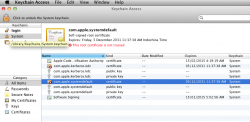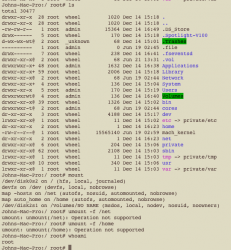Thank you Sir for the effort you went to, and I appreciate this topic would be a yawn for you but then I'm not entirely sure that yawning can be correct here. Because...I had read a couple of these already, and have read them all (and more) now, but the questions remain un-answered (I believe).
Google search terms:
com.apple.systemdefault root certificate
In the top few results:
http://support.apple.com/kb/TS1452
See the
Additional Information sub-heading on that page.
Important: You should not modify or delete the "com.apple.kerberos.kdc" certificate or key pair from Keychain Access, even if the certificate is marked as "This root certificate is not trusted."
Additional Information
Starting with Mac OS X 10.5 Leopard, each Mac OS X client maintains a local KDC for use with Bonjour and peer-to-peer security. This means it is a part of Back to My Mac (.Mac), local file sharing, and Leopard Screen Sharing.
That's all good and well, but I don't use Bonjour. I have zero desire to connect to peers. I will never use Back to My Mac, I have no requirement nor any desire to share files (either locally, or remotely), and the same goes for sharing my screen.
So I wish to remove these exploits which I don't need. Apple CS may or may not have touched a computer before, between them. I have been given no evidence whatsoever to believe that they have any idea whatsoever about anything Apple / MacBook Air / Networking / Lion / Computer related.
During the installation of Mac OS X 10.5, a computer-specific security certificate named "com.apple.kerberos.kdc" is created and entered into the Keychain along with a public/private key pair. This certificate and the associated keys are visible in the System Keychain in Keychain Access. You may notice that this certificate is marked as "This root certificate is not trusted." This is by design, as the certificate is only intended to be accessed by those specific programs and services designed to use local KDC authentication and does not indicate an issue with the certificate or Keychain.
?? This makes very close to zero aka (non)sense. Either it's trusted to perform the limited duties it's ostensibly certified to perform, or it isn't. The above is clearly nonsensical and therefore ludicrous. I've read it 15 times and it just gets more ridiculous each time. I'm calling it out.
Google search terms: DS_Store
The Wiki for DS_Store is entirely unsatisfactory, but then it does link to an adobe.com page which correctly sums up this outrageous imposition.
http://kb2.adobe.com/cps/168/tn_16831.html
When a new directory is accessed using the OS X Finder, a .DS_Store file will be created in that directory. Once the directory is viewed using the Finder a .DS_Store file will be permanently created in that directory. Currently, the option to create a .DS_Store file can not be disabled.
Users should be concerned about .DS_Store files being uploaded to the web servers. Since .DS_Store files contain some vital folder information they can be exploited to obtain information about system configurations. Please see the following third-party link for more information: Apple security updates.
Solution
To avoid creating .DS_Store files, do not to use the OS X Finder to view folders. An alternative way to view folders is to use UNIX command line.
It's an option which cannot be disabled. Some option. To protect against the imposed non-optional security risk, you have the option to not use Lion. This is just ridiculous. There's no other word for it.
After complaints from users about these files being created on remote systems, Apple posted an article on its support site detailing how to disable the creation of remote .DS_Store files over network connections.[5] However, this instruction does not apply for local drives, including USB flash drives.
Apple creates a unnecessary security exploit.
After complaints from users, Apple posts a semi-but-incomplete 'workaround' for users who want to protect themselves from the unnecessary and outrageously invasive incursion into territory which has absolutely nothing to do with Apple or HFS or Finder or OX S.
Apple doesn't remove the security exploit, mind! Users who are unaware or get frustrated with the ridiculous process, are out of luck aren't they?
And finally, there are no 'workaround' solutions whatsoever for portable drives.
Why am I pointing out the obvious, when it's almost 2012? You all have owned Apple machines for a long time, no?
Regarding .Trashes (which is not a mount point, BTW)...
Google search terms:
".trashes" mac
The top result:
http://www.westwind.com/reference/os-x/invisibles.html
(The quoting of .trashes in the search terms ensures google doesn't strip the leading dot.)
This is hardly a reference page worth linking to.
/usr/standalone
Contains boot loader programs for (potentially) various computer architectures. In the installs I've looked at, this is simply a duplicate of the BootX loader (also found in /System/Library/CoreServices/BootX); I'm not sure why both copies are needed.
Yeah that fills me with confidence that he's - clearly - an authoritative source.
Reasons for invisibility
In Mac OS X, there are three different ways a file or directory can be made invisible in the finder: it can have the "invisible" attribute set (as in older Mac OS systems), its name can start with "." (as in other unix systems), or its name can be listed in the /.hidden file. Many of the files and directories listed above are actually invisible for multiple reasons (e.g. /bin is listed in /.hidden, as well as having its invisible attribute set).
Note that OS X only respects the .hidden file on its boot volume, so if you boot from another disk, several normally-hidden files will suddenly be visible. Also, since Mac OS 9 (and older versions) only recognize the invisible flag, even more of these files (mainly /.vol, /mach, /mach.sym, and sometimes .DS_Store) will be visible when you boot into Mac OS 9.
No, it's funny. But not one single REASON was given, in his "Reasons for Invisibility". Perhaps I've missed his reasons? Kindly point them out to me if I have, because I know all about why files are invisible. And it's beyond insulting and offensive to suggest that users would want to be deceived.
For their own benefit, right? hah. Best not to tell them. So creepy, all of this - unbelievably creepy.
But
if I may return to my original desire to unhand this forced imposition from my machine, how may I achieve this please (I paid AppleCare $300 for a support extras policy but they've never heard of a computer before). What I'm demanding is not exactly complex. Where is this app gone off to?
I imagine it had to be dumped to make way for the 20 language packs which comprise the majority of every English Lion Install ESD image. Which I'm prevented from configuring, I wonder if that's normal actually...
ps. the reference to "mounts" wasn't about the .Trashes file which is another separate outrage altogether because I have OCD, which means, I delete files when I delete them - I do not, recycle them. And it's very insulting to suggest I require an option to 'change' my mind, when the files aren't even deleted by emptying the bin, not even deleted if you securely empty the bin, not even deleted if you reformat your hard drive, not even deleted if you zero-fill your drive. And probably, by that point, some outrageous unnecessary and ambiguiously-described dot files have ferried your compromising data to a safe - remote - location. And I'm yet to be sold on an argument that makes a convincing case that ATA Secure Erase commands do the job, either - but then maybe they do because Apple goes to some great lengths to make such a simple thing, impossible. Yes, impossible. I don't care if you can do it. It's impossible on my MBA. I've spent weeks trying and failing. Whilst AppleCare claims never to have used an Apple computer before, and the Geniuses don't care for the Terminal. And don't know about hidden files. Apparently. What a bunch of creeps.
But anyway, I don't recycle. So therefore, I should have zero .Trashes folders. Instead, I have hundreds or thousands. So someone is lying. But the reference to "mounts" was referring to the below list where my /home and /net folders are auto-mounted for reasons which seem dubious on account of my inability to dismount them (I delete the /etc files but they're just auto-mounted regardless). Impossibly valid question which will never be answered, number 4971.



